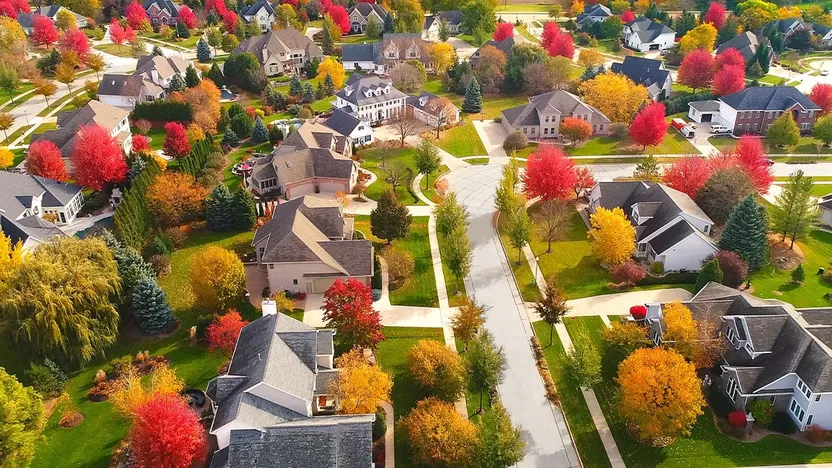Sep 1, 2022

The turbulent story of America’s housing market has yielded yet another surprise twist.
After steadily climbing to the record-shattering apex of $450,000 in June, home prices are at long last taking the plunge. From July to August, national prices dropped from $449,000 to $435,000, their most significant month-to-month plunge in data history dating back to 2016, according to a new report by Realtor.com®.
Granted, home prices in August are still up annually by 14.2% from a year earlier. But weary homebuyers may see a further break in the clouds come fall, which is generally the best time to buy a home.
“It’s the time of year when prices typically slow,” explains Realtor.com Chief Economist Danielle Hale. “We usually see a peak in median listing prices in June, and then prices come down as we move toward the end of the year.”
‘We’re seeing a shift in the balance’
For homebuyers, this news of plummeting prices will no doubt be a welcome reprieve from the steady dose of drama spurred by the COVID-19 pandemic. Home prices not only soared over the past two years, but properties were scarce, and buyers snapped up what was available at a record-setting pace.
But in August, the national inventory of properties for sale jumped by 27%, with 166,000 more listings compared to last year. And the median amount of time a house spent on market increased for the first time since June 2020, lengthening by five days since last year to 42 days.
“This year, in addition to the usual seasonal cooling, we’re seeing a shift in the balance of supply and demand,” explains Hale. “After years of demand vastly outstripping supply—forcing buyers who wanted to find a home to bid up prices—supply has increased. And that means price growth has cooled.”
And as days on market increased, this stagnation forced more sellers to slash their prices; the percentage of price reductions rose from 11% last August to 19.4% this year (which is close to 2019 levels).
This means home shoppers may gain the upper hand when it comes to negotiation and a final sales price. It may even drive down median list prices further in the coming months and extinguish the red-hot seller’s market once and for all.
“Sellers are starting to adjust their expectations of the market, down from the sky-high prices,” says Hale.
‘Buyers can be more selective now’
Housing inventory has still not completely returned to pre-pandemic levels. August’s total number of active listings is still 7.7% below where they were in 2020.
Yet the good news is that the number of homes actively for sale in the 50 largest U.S. metros increased by 39.8% over last year. (Metros include the central city, surrounding suburbs, towns, and smaller urban areas.)
And some once-impenetrable markets are now seeing listings rise by shocking numbers.
Take the pandemic boomtown of Raleigh, NC, a once-sizzling market at the height of the real estate craze. In August, Raleigh’s number of active listings shot up an astounding 176.6% compared with last year, making it the highest increase in the top 50 metros.
“Buyers can be a little more selective now, and homes that are priced without factoring that in may indeed linger on the market and ultimately take a price reduction,” says Debbie Van Horn, founding real estate agent Compass in Raleigh, NC. “In the recent two years, homes were priced and readily sold, without considering upgrades, condition, floor plan utility—all the things that truly affect a home’s value. That will have to shift back to typical pricing strategies. Buyers ultimately set the price.”
Other former hotbeds that saw booming pandemic demand—including Phoenix and Austin, TX—also saw their inventory levels increase by more than 100% year over year.
Is a buyer’s market in the cards for fall?
Even though buyers are finally catching a break in terms of home prices, they’re still facing high inflation and mortgage rates, which now average about 5.8% for a fixed-rate 30-year-mortgage.
Increasing rates have caused the cost of a monthly loan on a typical home to soar by 53% compared to a year ago. (This assumes buyers put down 20% and doesn’t include property taxes, insurance, and homeowners association fees.)
And although America’s red-hot market has cooled somewhat, it’s by no means a buyer’s market. Rather, we may all face a more balanced housing market where buyers and sellers will continue to battle it out on more even footing.
“Home prices are likely to remain high, which is a con for many,” says Hale. “But if you can find a home that meets your needs and fits your budget, you may be able to lock in a majority of your housing costs with a fixed-rate mortgage.”
Source- https://www.realtor.com/news/trends/housing-inventory-report-2022-august/






